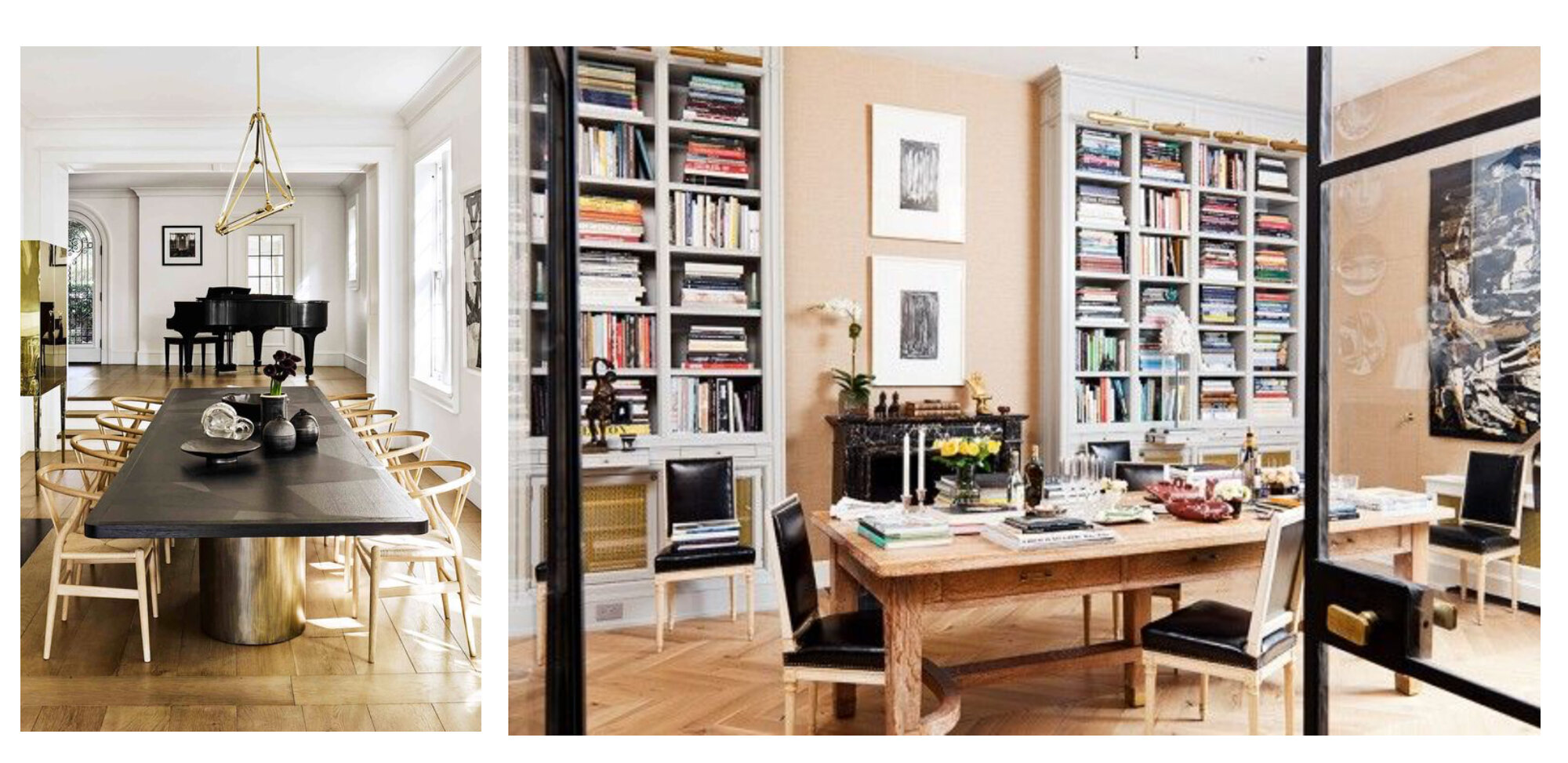Is the Dining Room the New Boardroom?
Dining Room By Nicole Hollis
With the growing potential for WFH experiences on an increasing scale, what does it look like when it’s no longer just occasional? What does it look like on a grander scale? Is the Dining Room the New Boardroom? In this new climate, we are all learning just how important our alternate workspaces are. Working from the kitchen island or breakfast table may give you a work surface but what happens at the end of the day? Where does the paper go? How do you remain set to resume the next day? How does this workspace look like through a camera? It is even more important in recent days to be able to put your best foot forward, in front of clients and business colleagues.
In the current work from home climate, many of us are searching for inspiration regarding home workspace options. AD and other publications send out emails with features on home workspaces. Like many of you, I gaze longingly at spaces that look not only inviting but also functional. In my own habitat, I work from a glam console table, design materials in bins stacked in corners, with papers stacked along an oversize cocktail table. For many of us, the dining table has become our virtual boardroom. Having recently transitioned to a new residence, I am currently without a dining table or desk, but you can be sure that I have several options in mind. I am also recovering OCD. For me, there is never enough empty counter space or concealed storage. I will be adding two tall cabinets to hold samples and client files. My point is that I too know the frustration of having a home workspace that is less than ideal.
As we are all evaluating what having an ideal space looks like moving forward, I want to share a few different styles of home workspaces that are not only highly productive but also welcoming.
Scenario 1: The Study or Home Office
Project 1: In this first home office, new construction, our client requested the ability to share the room with his daughter, along with plenty of concealed storage and filing space. The room has a 10 ft ceiling. We specified full height upper cabinets, a wall to wall tackspace, wood-clad commercial file cabinets, and a cantilevered custom desk that easily accommodates a person or two on each side. Not only does desk support multiple users and piles of materials but it also provides support for the work wall countertop. I regularly specify the file cabinets I chose for this project for two reasons: One they are structurally stable, and two, you get the full width of the drawers to accommodate both legal and letter files. In this case, the shallow drawer holds easy to reach office supplies and other quick reach items all at standard desk height. Task lighting is provided by under cabinet lighting, recessed downlights, and staggered modern pendants above.
Project 2: For this workspace, an existing bonus room was converted to provide not only a desk space but also a lounge area with a balance between open shelving and concealed storage. Critical to the design solution was creating a space that met the work needs of the current user and could be easily changed to a playroom or multipurpose room for a future owner. In the left image, a custom cantilevered desk anchors to the adjacent bookcase, a single metal bracket allows it to be removed as needs change. In its daily life, the panel at the end of the desk is removed, providing access to the outlets and other necessities beyond. On the far right of this photo, a series of full-height cabinets provide concealed storage. Task lighting is provided by a desk lamp and recessed fixtures. The space includes an ensuite full bath.
Scenario 2: Workspace in a Multi-purpose Room
The Dining Room
The Dining Room is poised to become the New Boardroom. For most of us, it is the room that is least occupied and also most dressed to impress. However, having paperwork and other work materials strewn all across when not in use is an eyesore. Not the most attractive view upon entering your front door. The photos above offer two solutions to this dilemma. In addition, both add style points to their spaces. On the left, a sleek, polished metal cabinet provides additional storage while flanking the fireplace. Ideally, there would be two flanking either a wide doorway or fireplace. One for entertaining and the other for work storage. These could also be placed right outside a wide cased opening in the corridor or entry. Perhaps the choice is a low cabinet providing a platform for art above, a few well-chosen accessories, and a lamp while creating a serving space for dining events. On the right, narrow depth bookshelves incorporate storage cabinets at their base. Pull out shelves provide layout out space for work materials, books and sculpture. The take-aways are that furniture can always be located elsewhere, in another life or location. The sleek cabinet above could hold shoes, accessories, or clothing in a closet. Why not put a little glam in your closet? Bookshelves….cozy, welcoming. I absolutely adore this concept when space permits. What is notable is that the base cabinet is the same depth as the top. Too often I have seen the base cabinet at 24” depth or similar, creating a problem for getting around the furniture and not really contributing anything more than extra “dead” junk space.
Left Image: Nicole Hollis. Right Image: Nate Berkus.
The Master Bathroom or Dressing Room
In the sumptuous master bathroom/dressing room above, the room becomes a virtual command center.
Above Image: Brad Dunning.
A Bedroom
Eastern tradition holds that in order to truly rest, it is necessary to create a visually quiet environment. Today’s Master Bedrooms often offer room for a desk and/or seating area. However, nothing says sweet dreams like a pile of papers in view from your bed. Like a siren they call out for just 5 more minutes, creating virtual hamster wheels in your weary mind. So I am not a fan of using that desk as a primary worksurface. Better yet. to locate that in a secondary bedroom, providing you with a spatial boundary and a door that can be closed. Above are some ideas for incorporating this function into your space. A desk set into a window niche. A console table as a headboard or located at the foot of the bed. Can’t you just see looking out over the bed at a beutiful view from those wide windows? Or a radiator disguised by a built in desk top/dressing table at a window.
Left Image: artofdecor.ru. Center Image: Andrew Martin Design Review. Right Image: Francesc Rifé Studio.
The Living Room
Clearly our classic solution, the desk or console, would be welcome here. However, the wall mount floating console offers a rich alternative. Ripe with opportunities to anchor art or tableau accessories, these versions created by ganging multiple units provide loads of storage as well and can easily work with a pull-up chair or ottoman. Shallow in depth, they provide loads of function without claiming a lot of precious floor space. Items may even be placed below.
Left Image: Artist William McClure. Right Image: Rimadesio
The Entry Hall
Two matching tall cabinets act as pedestals for sculptural objects while providing stylish hidden storage. The sculptural desk creates a perfect entry table when not in use.
Above Image: Serge Castella.
Scenario 3: Workspace incorporated into circulation space
These two designs feature in predominantly open floor plans. Core function is situated with paths of circulation wrapping around. On the left, part of a full-height white oak bank of storage, A desk pivots from the wall to the corridor when in use. Supported by a pedestal file cabinet, the desk and bench stack under the bookshelves and hide behind full height flat panel doors when not in use. On the right, warm coral red features in this open shelving work wall complete with drawers and files.
Image Left: StudioK.be. Image Right: John Wardis Architects.
On the left, A shallow floating console occupies a niche that could have easily been an entry closet in a past life. The reveal on the right side could indicate a full-height panel door offering concealed storage. Center, a modular storage system, incorporating display and desk space minimally projects into this corridor. Corridor storage becomes a design feature. Right, A wall mount desk cabinet projects out 8-12” into the space around it. When the top is up, the sculptures reside upon a sleek wall mount wood cabinet. A cabinet such as this could also be located along a stair landing.
Left Image: Walker Warner Architects. Center Image: Filip Janssens.be. Right Image: Ellwood-Lomax
In both, the above images, cantilevered desktops with drawers tuck behind full-height panel doors when not in use, fading into the wall. Seating tucks into the knee space. Whether along a corridor or along the circulation path in a kitchen, both options provide adjacent storage
Left Image: Agata Zajkowski Interior Design. Right Image: Matyas Architects, Interior Styling by Nina Provan.
Above Image: A concealed cabinet lies at the end of bookshelves in this minimalist interior.
Scenario 4: Just about anywhere
in the three above images, functional workspaces that use minimal floor space are shown. On the left, a cantilevered console lies at the end of a corridor outside a primary room. Center, a 12” deep built-in bookshelf /desk unit, inspired by Designer William T. Georgis, provides a workspace for a young musician without taking up valuable floor space. On the right, a full-height storage wall provides not only architectural interest but also makes great use of an otherwise blank wall with minimal impact on the square footage of the space it occupies. Note that the drop-down desktop is supported by lower cabinet doors below.
Left Image: Artem Babayants Architects. Center Image: Habitat Roche. Right Image: Hagar Abiri.
Scenario5: Alternative Desks
Lastly, a bit tongue in cheek, the desk above utilizes dog crates that are often difficult to work with concerning location and aesthetic as desktop supports. What a fabulous way in this room to put them to work. Above Image: Ryan White.
Whether you have a dedicated room or need to carve out space, these spaces are chosen to inspire you and get the wheels turning. If you find yourself “at ends” or just need a little finesse, we are available to help.
As always - It’s “The Details” that matter!
ABOUT THE DESIGNER
Native Houstonian, Laura Roach, is the Founder and Creative Director of Habitat Roche Interior Design. A boutique design studio serving both Residential and Commercial Clientele.














